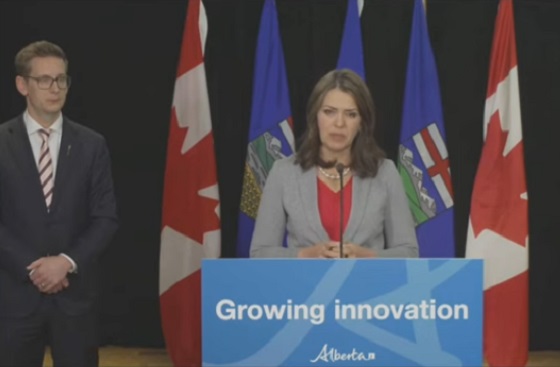Alberta
Alberta laying out the welcome mat for AI Data Centres

Fueling innovation through AI data centre attraction
Alberta’s government is aiming for Alberta to become North America’s destination of choice for Artificial Intelligence (AI) data centre investment.
The AI data centre attraction strategy identifies three pillars that create the foundation of Alberta’s work to position itself as a competitive player in the global AI landscape: power capacity, sustainable cooling and economic diversification. In each of these strategic areas, there are policy and regulatory levers required in addition to other steps Alberta’s government is taking to ensure Alberta is the most attractive and competitive destination for this emerging sector. The entire approach prioritizes competitive advantages, economic integration, market stability and keeping utilities reliable and affordable.
“Artificial intelligence is behind all the newest technologies we rely on to make our lives better, simpler, safer. There’s incredible opportunity around artificial intelligence and we are unafraid to dream big. This strategy will position Alberta as the place to invest and build AI data centres, further building on our reputation as a province with no limit to innovation and opportunity.”
The world’s largest AI companies are in search of opportunities to build and energize their data centres. Alberta, with its abundant natural gas supply and world-class power industry, is highly attractive to AI data centre projects. The province’s unique competitive power market opens the door to many opportunities for AI companies to partner with Alberta’s talented and experienced electricity sector. The sector has decades of experience in finding innovative solutions to meet industry’s power needs while maintaining a balance of affordability and reliability in a system that Albertans count on.
AI data centres generate a lot of heat and require cooling. The strategy encourages operators to determine the cooling technology best suited for their needs, water license availability and regional and project circumstance. Additionally, Alberta’s climate offers significant advantages for AI data centres because of the province’s cold winters, which would reduce the need for artificial cooling systems.
Alberta’s government seeks to ensure Albertans benefit from AI data centres and is committed to ensuring economic growth and shared prosperity while ensuring Alberta continues to have the lowest taxes in Canada and is competitive across North America.
“Alberta is uniquely positioned to capture the AI data center opportunity, leveraging our vast natural gas resources and pro-business environment to create thousands of high-quality jobs and attract billions in investment. This strategy is not just about building infrastructure; it’s about fostering innovation and establishing Alberta as a hub for high-tech industries, driving economic growth and supporting critical public services like healthcare and education.”
Alberta is committed to fostering innovation and ensuring technology development aligns with industry needs. The strategy was developed after extensive consultation with organizations and businesses in the AI space and market participants.
“For AI companies to build and scale in Alberta, they need access to computing power. Data centers are economic growth engines that provide the computing power AI companies need to develop and deploy their innovations. grow their companies and stimulate the local economies. Beyond its natural advantages, Alberta boasts a robust AI ecosystem anchored by world-class research and talent. Many of the algorithms the world’s data centers are running on have been pioneered by Amii researchers right here in Alberta. The opportunity for those companies to be close to the source of some of the leading AI research gives them a competitive advantage in being at the forefront of what is coming next.”
Quick facts
- Over the past several months, Technology and Innovation met with AI data centre builders and operators, power generators, natural resource sector participants, telecommunications companies and municipalities actively pursuing AI data centres.
- AI data centre market size is anticipated to more than double by 2030 to more than $820 billion. (P&S Market Research)
- Alberta Electricity System Operator (AESO) has 12 data centre projects on their project list totalling 6,455 MW of load.
- Most of the power demand on the AESO project list is from data centers.
- Currently there is about 1,000 MW of additional dispatchable generation over Alberta’s current needs. This amount is dynamic and may change due to factors such as generation retirements, outages, derates, or new additions.
Related information
Alberta
Red Deer Justice Centre Grand Opening: Building access to justice for Albertans

The new Red Deer Justice Centre will help Albertans resolve their legal matters faster.
Albertans deserve to have access to a fair, accessible and transparent justice system. Modernizing Alberta’s courthouse infrastructure will help make sure Alberta’s justice system runs efficiently and meets the needs of the province’s growing population.
Alberta’s government has invested $191 million to build the new Red Deer Justice Centre, increasing the number of courtrooms from eight to 12, allowing more cases to be heard at one time.
“Modern, accessible courthouses and streamlined services not only strengthen our justice
system – they build safer, stronger communities across the province. Investing in the new Red Deer Justice Centre is vital to helping our justice system operate more efficiently, and will give people in Red Deer and across central Alberta better access to justice.”

Government of Alberta and Judiciary representatives with special guests at the Red Deer Justice Centre plaque unveiling event April 22, 2025.
On March 3, all court services in Red Deer began operating out of the new justice centre. The new justice centre has 12 courtrooms fully built and equipped with video-conference equipment to allow witnesses to attend remotely if they cannot travel, and vulnerable witnesses to testify from outside the courtroom.
The new justice centre also has spaces for people taking alternative approaches to the traditional courtroom trial process, with the three new suites for judicial dispute resolution services, a specific suite for other dispute resolution services, such as family mediation and civil mediation, and a new Indigenous courtroom with dedicated venting for smudging purposes.
“We are very excited about this new courthouse for central Alberta. Investing in the places where people seek justice shows respect for the rights of all Albertans. The Red Deer Justice Centre fills a significant infrastructure need for this rapidly growing part of the province. It is also an important symbol of the rule of law, meaning that none of us are above the law, and there is an independent judiciary to decide disputes. This is essential for a healthy functioning democracy.”
“Public safety and access to justice go hand in hand. With this investment in the new Red Deer Justice Centre, Alberta’s government is ensuring that communities are safer, legal matters are resolved more efficiently and all Albertans get the support they need.”
“This state-of-the-art facility will serve the people of Red Deer and surrounding communities for generations. Our team at Infrastructure is incredibly proud of the work done to plan, design and build this project. I want to thank everyone, at all levels, who helped make this project a reality.”
Budget 2025 is meeting the challenge faced by Alberta with continued investments in education and health, lower taxes for families and a focus on the economy.

Quick facts
- The new Red Deer Justice Centre is 312,000 sq ft (29,000 m2). (The old courthouse is 98,780 sq ft (9,177 m2)).
- The approved project funding for the Red Deer Justice Centre is about $191 million.
Alberta
CPP another example of Albertans’ outsized contribution to Canada

From the Fraser Institute
By Tegan Hill
Amid the economic uncertainty fuelled by Trump’s trade war, its perhaps more important than ever to understand Alberta’s crucial role in the federation and its outsized contribution to programs such as the Canada Pension Plan (CPP).
From 1981 to 2022, Albertan’s net contribution to the CPP—meaning the amount Albertans paid into the program over and above what retirees in Alberta received in CPP payments—was $53.6 billion. In 2022 (the latest year of available data), Albertans’ net contribution to the CPP was $3.0 billion.
During that same period (1981 to 2022), British Columbia was the only other province where residents paid more into the CPP than retirees received in benefits—and Alberta’s contribution was six times greater than B.C.’s contribution. Put differently, residents in seven out of the nine provinces that participate in the CPP (Quebec has its own plan) receive more back in benefits than they contribute to the program.
Albertans pay an outsized contribution to federal and national programs, including the CPP because of the province’s relatively high rates of employment, higher average incomes and younger population (i.e. more workers pay into the CPP and less retirees take from it).
Put simply, Albertan workers have been helping fund the retirement of Canadians from coast to coast for decades, and without Alberta, the CPP would look much different.
How different?
If Alberta withdrew from the CPP and established its own standalone provincial pension plan, Alberta workers would receive the same retirement benefits but at a lower cost (i.e. lower CPP contribution rate deducted from our paycheques) than other Canadians, while the contribution rate—essentially the CPP tax rate—to fund the program would likely need to increase for the rest of the country to maintain the same benefits.
And given current demographic projections, immigration patterns and Alberta’s long history of leading the provinces in economic growth, Albertan workers will likely continue to pay more into the CPP than Albertan retirees get back from it.
Therefore, considering Alberta’s crucial role in national programs, the next federal government—whoever that may be—should undo and prevent policies that negatively impact the province and Albertans ability to contribute to Canada. Think of Bill C-69 (which imposes complex, uncertain and onerous review requirements on major energy projects), Bill C-48 (which bans large oil tankers off B.C.’s northern coast and limits access to Asian markets), an arbitrary cap on oil and gas emissions, numerous other “net-zero” targets, and so on.
Canada faces serious economic challenges, including a trade war with the United States. In times like this, it’s important to remember Alberta’s crucial role in the federation and the outsized contributions of Alberta workers to the wellbeing of Canadians across the country.
-

 2025 Federal Election23 hours ago
2025 Federal Election23 hours agoTrump Has Driven Canadians Crazy. This Is How Crazy.
-

 2025 Federal Election1 day ago
2025 Federal Election1 day agoCarney’s Hidden Climate Finance Agenda
-

 2025 Federal Election2 days ago
2025 Federal Election2 days agoFormer WEF insider accuses Mark Carney of using fear tactics to usher globalism into Canada
-

 2025 Federal Election1 day ago
2025 Federal Election1 day agoThe Anhui Convergence: Chinese United Front Network Surfaces in Australian and Canadian Elections
-

 2025 Federal Election1 day ago
2025 Federal Election1 day agoStudy links B.C.’s drug policies to more overdoses, but researchers urge caution
-

 Automotive11 hours ago
Automotive11 hours agoHyundai moves SUV production to U.S.
-

 2025 Federal Election2 days ago
2025 Federal Election2 days agoConservatives promise to ban firing of Canadian federal workers based on COVID jab status
-

 International2 days ago
International2 days agoPope Francis Got Canadian History Wrong



